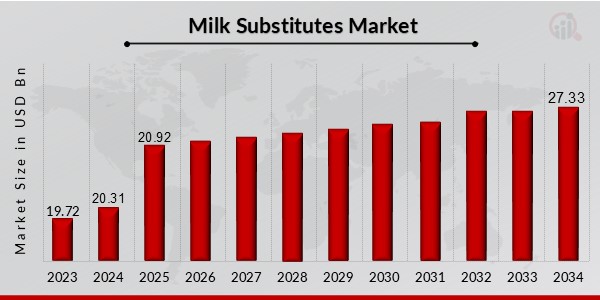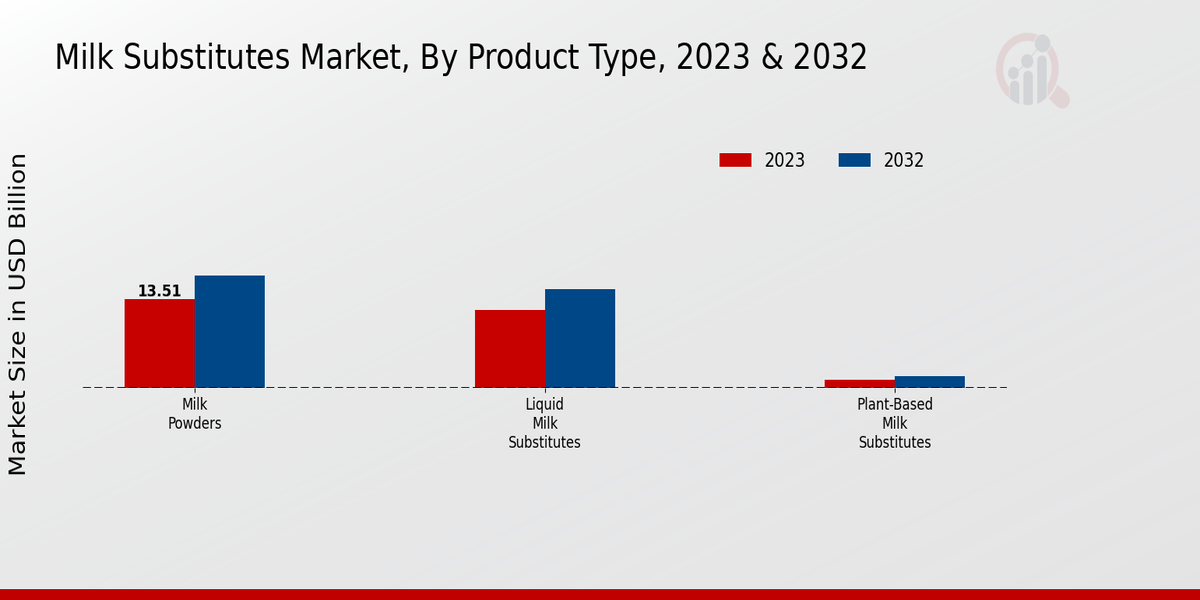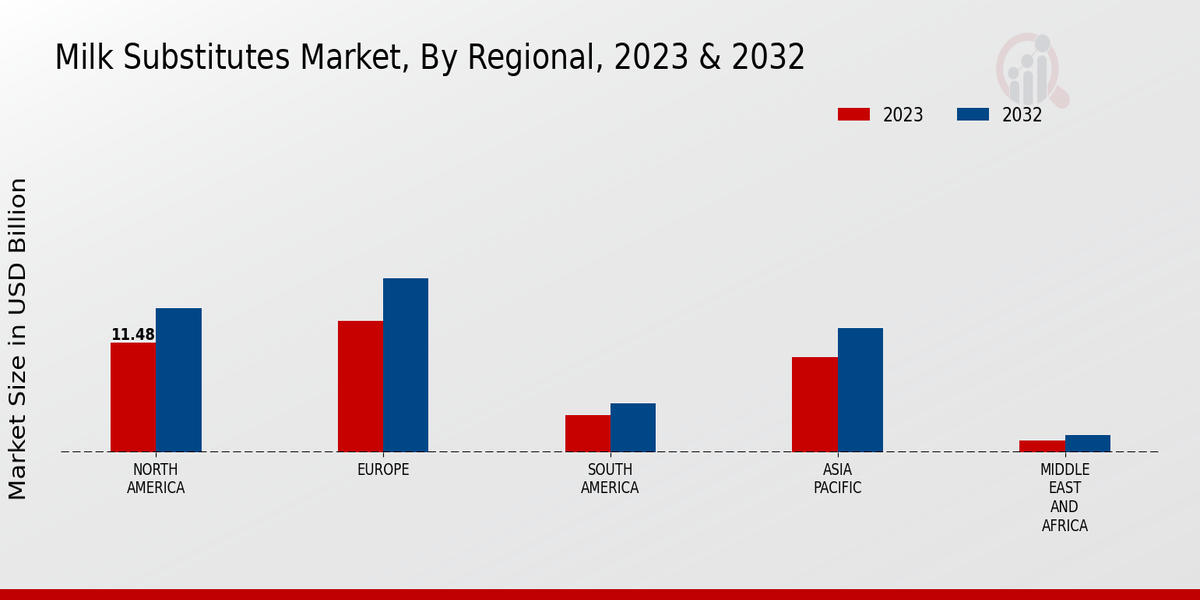Global Milk Substitutes Market Overview
Milk Substitutes Market Size was estimated at 20.31 (USD Billion) in 2024. The Milk Substitutes Industry is expected to grow from 20.92(USD Billion) in 2025 to 27.33 (USD Billion) by 2034. The Milk Substitutes Market CAGR (growth rate) is expected to be around 3.0% during the forecast period (2025 - 2034).

Source: Primary Research, Secondary Research, MRFR Database and Analyst Review
Key Milk Substitutes Market Trends Highlighted
Key market drivers of the milk substitutes market include increasing cases of lactose intolerance, increasing knowledge of the health advantages associated with nut milk, and increasing need for fortified and flavored milk substitutes. Additionally, opportunities are available to capitalize on the increased consumption of allergen-free and clean-label products. Butler & Kahn, PLLC (2018) note the increasing demand in the market for oat milk, almond milk, and soya milk. It is also noted that, within the market, new milk substitutes are being made from peas, seeds, nuts and other innovative ingredients. These trends reveal that there is a change in consumer demand for healthier and more environmentally friendly products and a shift in food technology towards more advanced development.
Milk Substitutes Market Drivers
Rising Demand for Plant-Based Milk Alternatives
The consumer shift toward plant-based diets and the growing consciousness regarding the environmental impact of animal husbandry have accelerated the growth of the milk substitute market. Soy milk, almond milk, and oat milk are generally considered healthier and more environmentally friendly than cow milk. Additional and ongoing consumer preference shifts toward these types of milk are expected to increase their demand over the next few years, further boosting the Milk Substitutes Market Industry.
Increasing Prevalence of Lactose Intolerance and Milk Allergies
Lactose intolerance and milk allergies represent common digestive disorders impacting a significant part of the population worldwide. While lactose intolerance is defined as the inability to digest a kind of sugar contained in milk, or lactose, allergy to milk means the inability of the immune system to accept proteins contained in milk. The increasing prevalence of such disorders results in the growing demand for milk substitutes – products that are lactose-free and hypoallergenic.Such a factor is expected to promote the growth of the Milk Substitutes Market Industry.
Government Regulations and Support for Plant-Based Industries
Governments across the globe are increasing efforts through legislation and support to expand plant-based industries such as milk alternatives. They are doing so to reduce the adverse environmental impact of animal husbandry, foster healthier dietary habits, and support more sustainable farming practices. As relatively new players in the market, the growth of the Milk Substitutes Market Industry is expected to be stimulated by this favorable regulatory environment.
Milk Substitutes Market Segment Insights
Milk Substitutes Market Product Type Insights
The Milk Substitutes Market is segmented into various product types, including Milk Powders, Liquid Milk Substitutes, and Plant-Based Milk Substitutes. These segments exhibit distinct characteristics in terms of market share, growth potential, and consumer preferences. Milk Powders remain a significant segment within the Milk Substitutes Market, accounting for a substantial revenue share in 2023. The market for Milk Powders is primarily driven by the growing demand for convenience and long shelf life. They are widely used in various applications, including infant formula, baking, and food processing.With rising urbanization and the increasing number of working parents, Milk Powders offer a practical and convenient alternative to fresh milk. Liquid Milk Substitutes, on the other hand, are gaining popularity due to their perceived health benefits and ease of use. Consumers are increasingly seeking healthier alternatives to traditional dairy products, and Liquid Milk Substitutes cater to this demand by offering a range of plant-based options, such as soy milk, almond milk, and oat milk.
The growing awareness of lactose intolerance and veganism has further contributed to the growth of the Liquid Milk Substitutes segment.Plant-Based Milk Substitutes are a relatively new segment within the Milk Substitutes Market, but they have witnessed significant growth in recent years. Driven by the rising popularity of plant-based diets and concerns about animal welfare, Plant-Based Milk Substitutes offer a sustainable and cruelty-free alternative to traditional dairy products. They are typically made from plant ingredients such as soy, almonds, oats, and coconut, and provide similar nutritional value to dairy milk. The increasing availability of Plant-Based Milk Substitutes in various flavors and forms is further fueling the growth of this segment.Overall, the Product Type segment of the Milk Substitutes Market is highly dynamic and constantly evolving. The growing demand for convenience, health-consciousness, and sustainability is driving the growth of this market. As consumer preferences and dietary habits continue to shift, it is expected that the Product Type segment will remain a key driver of the Milk Substitutes Market revenue in the years to come.

Source: Primary Research, Secondary Research, MRFR Database and Analyst Review
Milk Substitutes Market Source Insights
Milk Substitutes Market 2024-2032 The Milk Substitutes Market is classified based on the source into cow’s milk, soy milk, almond milk, oat milk, and coconut milk. In 2023, the cow’s milk segment held the largest market share of 42.1%. The market is expected to achieve a valuation of USD 10.6 billion by 2032, expanding at a CAGR of 2.9% in the course of the forecast period. The soy milk source will be the quickest developing segment, representing a CAGR of 4.1% from 2024 to 2032. The developing recognition of a vegan diet and increasing cognizance of lactose prejudice are prompting the increased demand for milk substitutes.Almond milk and oat milk are experiencing high demand due to their health benefits and additional uses.
Milk Substitutes Market End Use Insights
The Milk Substitutes Market segmentation by End Use includes Infant Nutrition, Dairy Alternatives, Baking and Confectionery, and Animal Feed. The Infant Nutrition segment accounted for the largest share of the market in 2023, and is projected to continue to dominate the market during the forecast period. The growing demand for infant formula and other milk substitutes for babies is driving the growth of this segment. The Dairy Alternatives segment is also expected to witness significant growth in the coming years, owing to the increasing popularity of plant-based milk substitutes such as almond milk, soy milk, and oat milk.The Baking and Confectionery segment is another major contributor to the Milk Substitutes Market revenue, as milk substitutes are widely used in the production of baked goods, chocolates, and other confectionery products. The Animal Feed segment is also expected to experience steady growth, as milk substitutes are used as a source of protein and nutrients for livestock.
Milk Substitutes Market Sales Channel Insights
Supermarkets and Hypermarkets dominated the Milk Substitutes Market revenue in 2023, accounting for over 45%. The widespread availability of a diverse range of milk substitutes, coupled with convenient shopping experiences, drives the segment's growth. Convenience stores are another significant sales channel, capturing approximately 20% of the market share. Their strategic locations and extended operating hours cater to consumers seeking quick and easy access to milk substitutes. Online retail has witnessed a surge in popularity, contributing nearly 15% to the Milk Substitutes Market revenue.The growing adoption of e-commerce platforms and the convenience of home delivery fuel this channel's expansion. Health food stores specializing in organic and natural products hold a niche market share of around 10%. The increasing health consciousness among consumers and the availability of specialized milk substitutes for specific dietary needs drive the growth of this segment.
Milk Substitutes Market Health Benefits Insights
The health benefits segment plays a pivotal role in driving the Milk Substitutes Market revenue. Lactose intolerance, a prevalent condition affecting a significant portion of the population, is a key factor propelling the demand for milk substitutes. Statistics indicate that nearly 65% of the population experiences some degree of lactose intolerance. Milk substitutes offer a viable alternative for these individuals, providing essential nutrients without the discomfort associated with lactose consumption. Furthermore, the rising prevalence of dairy allergies, especially among children, has contributed to the growth of the Milk Substitutes Market.Dairy allergies, which affect approximately 2-3% of infants, can cause severe reactions ranging from skin rashes to anaphylaxis. Milk substitutes provide a safe and nutritious option for individuals with dairy allergies, enabling them to meet their nutritional needs without compromising their health. Veganism, a lifestyle choice that excludes all animal-based products, has also fueled the demand for milk substitutes. The increasing popularity of veganism, driven by ethical concerns, environmental consciousness, and health benefits, has led to a surge in the consumption of plant-based milk substitutes.Market data suggests that the vegan milk market is projected to reach USD 38.29 billion by 2032, exhibiting a CAGR of 12.6%. Additionally, the growing emphasis on weight management has contributed to the demand for milk substitutes with reduced fat and calorie content. Milk substitutes, such as almond milk and soy milk, are often perceived as healthier alternatives to traditional dairy milk, as they contain fewer calories and saturated fats. This has resonated with health-conscious consumers seeking to maintain a balanced diet and reduce their risk of obesity and related chronic diseases.
Milk Substitutes Market Regional Insights
The Milk Substitutes Market is segmented into North America, Europe, Asia Pacific, South America, and the Middle East and Africa. North America is the largest regional market, accounting for about 40% of the market share. Europe is the second largest market, with a share of around 30%. The Asia Pacific region is expected to grow at the fastest rate over the next few years, with a CAGR of over 5%. The growth of the milk substitutes market in North America is being driven by the increasing demand for plant-based milk alternatives, such as almond milk and soy milk.Growing concerns over lactose intolerance and milk allergies are also contributing to the growth of this market. In Europe, the market is being driven by the increasing popularity of vegan and vegetarian diets. The demand for milk substitutes in the Asia Pacific region is being driven by the growing middle class and the increasing awareness of the health benefits of plant-based milk alternatives.

Source: Primary Research, Secondary Research, MRFR Database and Analyst Review
Milk Substitutes Market Key Players And Competitive Insights
Major players in the Milk Substitutes Market industry are constantly innovating and developing new products to meet the changing demands of consumers. Leading Milk Substitutes Market players are investing heavily in research and development to create products that are more nutritious, sustainable, and affordable. The Milk Substitutes Market development is being driven by the increasing demand for plant-based alternatives to dairy products. This is due to the growing number of people who are lactose intolerant, vegan, or who simply want to reduce their consumption of animal products. The Milk Substitutes Market Competitive Landscape is expected to remain highly competitive in the coming years, with new players entering the market and existing players expanding their product offerings.Nestlé is a leading company in the milk substitutes market. The company offers a wide range of milk substitutes, including plant-based milks, infant formula, and nutritional drinks. Nestlé is committed to providing high-quality, nutritious products that meet the needs of consumers around the world. The company has a strong presence and is well-positioned to continue to grow its market share in the Milk Substitutes Market.Danone is a competitor company in the milk substitute market. The company offers a range of milk substitutes, including plant-based milks, infant formula, and medical nutrition. Danone is committed to providing healthy, affordable products that meet the needs of consumers around the world. The company has a strong presence and is well-positioned to continue to grow its market share in the Milk Substitutes Market.
Key Companies in the Milk Substitutes Market Include
-
Royal FrieslandCampina
-
Bellamy's Organic
-
Kendamil
-
Danone
-
HiPP
-
Abbott Laboratories
-
Mead Johnson Nutrition
-
Gerber
-
Bubs Australia
-
Fonterra
-
FrieslandCampina
-
Danone North America
-
Nestlé
-
Arla Foods
Milk Substitutes Market Industry Developments
Recent developments in the Milk Substitutes Market include the growing popularity of plant-based milk alternatives, such as almond milk, oat milk, and soy milk. This trend is being driven by increasing consumer demand for healthier and more sustainable food options. In addition, there is a growing awareness of the environmental impact of dairy farming, which is leading some consumers to switch to plant-based alternatives.Another notable development in the milk substitutes market is the rise of personalized nutrition. Consumers are increasingly seeking out milk substitutes that are tailored to their individual dietary needs and preferences. This has led to the development of a wide range of new milk substitute products, such as those that are fortified with vitamins and minerals or those that are specifically designed for people with lactose intolerance or other dietary restrictions.The Milk Substitutes Market is expected to continue to grow in the coming years, driven by the increasing popularity of plant-based alternatives and personalized nutrition. Market analysts predict that the market will reach a value of USD 25.0 billion by 2032, with a CAGR of 3.01% over the forecast period.
Milk Substitutes Market Segmentation Insights
-
Milk Substitutes Market Product Type Outlook
-
Milk Substitutes Market Source Outlook
-
Cow's Milk
-
Soy Milk
-
Almond Milk
-
Oat Milk
-
Coconut Milk
-
Milk Substitutes Market End Use Outlook
-
Infant Nutrition
-
Dairy Alternatives
-
Baking and Confectionery
-
Animal Feed
-
Milk Substitutes Market Sales Channel Outlook
-
Milk Substitutes Market Health Benefits Outlook
-
Lactose Intolerance
-
Dairy Allergy
-
Veganism
-
Weight Management
-
Milk Substitutes Market Regional Outlook
-
North America
-
Europe
-
South America
-
Asia Pacific
-
Middle East and Africa
| Report Attribute/Metric |
Details |
| Market Size 2024 |
20.31(USD Billion) |
| Market Size 2025 |
20.92(USD Billion) |
| Market Size 2034 |
27.32(USD Billion) |
| Compound Annual Growth Rate (CAGR) |
3.0% (2025 - 2034) |
| Report Coverage |
Revenue Forecast, Competitive Landscape, Growth Factors, and Trends |
| Base Year |
2023 |
| Market Forecast Period |
2025 - 2034 |
| Historical Data |
2019 - 2023 |
| Market Forecast Units |
USD Billion |
| Key Companies Profiled |
Royal FrieslandCampina, Bellamy's Organic, Kendamil, Danone, HiPP, Abbott Laboratories, Mead Johnson Nutrition, Gerber, Bubs Australia, Fonterra, FrieslandCampina, Danone North America, Nestlé, Arla Foods |
| Segments Covered |
Product Type, Source, End Use, Sales Channel, Health Benefits, Regional |
| Key Market Opportunities |
Rising demand from lactose-intolerant populationGrowing awareness about the nutritional benefits of plant-based substitutesIncreasing prevalence of special dietary requirementsExpanding applications in the food and beverage industryInnovations in plant-based milk substitutes |
| Key Market Dynamics |
Increasing demand for plant-based alternatives Growing prevalence of lactose intolerance Rising health consciousness Technological advancements in milk substitutes Expanding retail distribution channels |
| Countries Covered |
North America, Europe, APAC, South America, MEA |
Frequently Asked Questions (FAQ) :
The Milk Substitutes Market is estimated to reach USD 27.32 billion by 2034, growing at a CAGR of 3.0% from 2025 to 2034.
Asia Pacific is expected to dominate the Milk Substitutes Market, accounting for the largest market share during the forecast period.
Rising demand for plant-based alternatives to dairy products, increasing prevalence of lactose intolerance and milk allergies, and growing awareness of the health benefits of milk substitutes are key factors driving market growth.
Milk Substitutes are primarily used in infant formula, dairy-free beverages, baked goods, confectionery products, and as an ingredient in various food and beverage applications.
Key competitors in the Milk Substitutes Market include Abbott Laboratories, Danone S.A., Nestlé S.A., The Hain Celestial Group, Inc., and Arla Foods amba.
The top 5 players in the Milk Substitutes Market are estimated to account for approximately 50-60% of the market share.
Challenges faced by the Milk Substitutes Market include competition from traditional dairy products, high production costs, and regulatory compliance requirements.
Key growth opportunities for the Milk Substitutes Market include expanding into emerging markets, developing new product innovations, and increasing consumer awareness about the benefits of milk substitutes.
Recent trends in the Milk Substitutes Market include the growing popularity of plant-based milk substitutes, such as almond milk, oat milk, and soy milk.
The Milk Substitutes Market is expected to grow at a CAGR of 3.0% from 2025 to 2034.

















